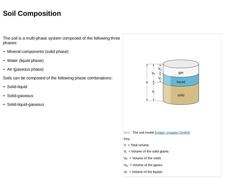
|
|
|
|
|
|
The soil is a multi-phase system composed of the following three phases: Soils can be composed of the following phase combinations: -
Solid-liquid
-
Solid-gaseous
-
Solid-liquid-gaseous
|
|
(Image: The soil model) |
|
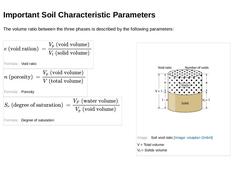
|
The volume ratio between the three phases is described by the following parameters: (Formula: Void ratio) (Formula: Porosity) (Formula: Degree of saturation) |
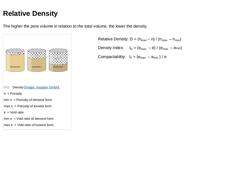
|
The higher the pore volume in relation to the total volume, the lower the density. (Image: Density) Relative Density: D = (nmax – n) / (nmax – nmin) Density Index: lD = (emax – e) / (emax – emin) Compactability: lF = (emax – emin ) / e |
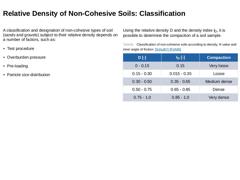
|
A classification and designation of non-cohesive types of soil (sands and gravels) subject to their relative density depends on a number of factors, such as: Using the relative density D and the density index lD, it is possible to determine the compaction of a soil sample. (Table: Classification of non-cohesive soils according to density, N value and inner angle of friction) |
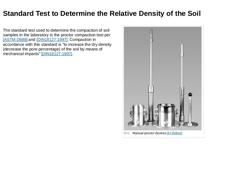
|
The standard test used to determine the compaction of soil samples in the laboratory is the proctor compaction test per [[ASTM D698]] and [DIN18127:1997]. Compaction in accordance with this standard is “to increase the dry density (decrease the pore percentage) of the soil by means of mechanical impacts” [DIN18127:1997]. (Image: Manual proctor devices) |
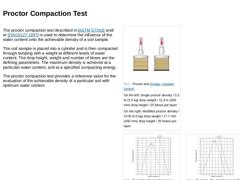
|
The proctor compaction test described in [[ASTM D7263]] and/or [DIN18127:1997] is used to determine the influence of the water content onto the achievable density of a soil sample. The soil sample is placed into a cylinder and is then compacted through tamping with a weight at different levels of water content. The drop height, weight and number of blows are the defining parameters. The maximum density is achieved at a particular water content, and … |
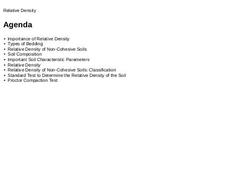
|
|

|
Cohesive soils change their state depending on the water content. When the water content is very high, these soils become liquid. When the water content decreases, they transition from a liquid to a plastic condition, then to semi-solid and finally to a solid condition. Thus, with a decreasing water content, cohesive types of soil become less mouldable, while their strength increases. The water contents at which the soil consistency is transformed … |

|
The determination of the consistency (condition) can be done both in situ and in the laboratory. In the case of the in-situ test, the condition of a cohesive type of soil is to be determined as follows: -
A type of soil is called “very soft, if it runs through the fingers while being pressed together in a fist;
-
Soft, if it can be kneaded easily;
-
Firm, if, although it is hard to be kneaded, it can be rolled out to 0.12 in (3 mm) thick rolls in the …
|
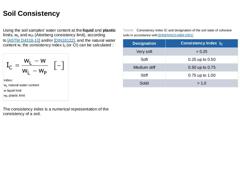
|
Using the soil samples' water content at the liquid and plastic limits, wL and wP (Atterberg consistency limit), according to [[ASTM D4318-10]] and/or [DIN18122], and the natural water content w, the consistency index IC (or CI) can be calculated : (Formula: Consistency index) The consistency index is a numerical representation of the consistency of a soil. (Table: Consistency index IC and designation of the soil state of cohesive soils in accordance … |
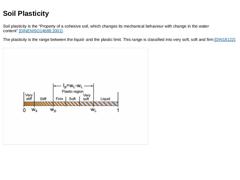
|
Soil plasticity is the “Property of a cohesive soil, which changes its mechanical behaviour with change in the water content” [DINENISO14688:2001]. The plasticity is the range between the liquid- and the plastic limit. This range is classified into very soft, soft and firm [DIN18122]. (Image: Consistency band [Trian00]) |
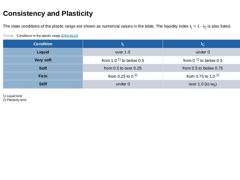
|
The state conditions of the plastic range are shown as numerical values in the table. The liquidity index IL = 1 - IC is also listed. (Table: Conditions in the plastic range [DIN18122]) |
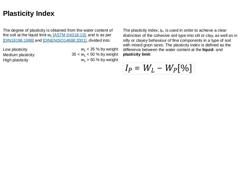
|
The degree of plasticity is obtained from the water content of the soil at the liquid limit wL [[ASTM D4318-10]], and is as per [DIN18196:1988] and [DINENISO14688:2001], divided into: |
Low plasticity |
wL < 35 % by weight |
|
Medium plasticity |
35 < wL < 50 % by weight |
|
High plasticity |
wL > 50 % by weight |
The plasticity index, IP, is used in order to achieve a clear distinction of the cohesive soil type into silt or clay, as well as in silty or clayey … |
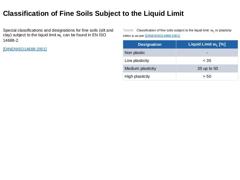
|
Special classifications and designations for fine soils (silt and clay) subject to the liquid limit wL can be found in EN ISO 14688-2. [DINENISO14688:2001] (Table: Classification of fine soils subject to the liquid limit wL or plasticity index IP as per EN ISO 14688-2) |
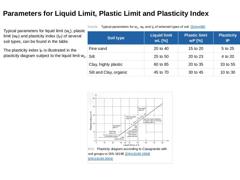
|
|
Typical parameters for liquid limit (wL), plastic limit (wP) and plasticity index (IP) of several soil types, can be found in the table. The plasticity index IP is illustrated in the plasticity diagram subject to the liquid limit wL. |
(Table: Typical parameters for wL, wP and IP of selected types of soil) (Image: Plasticity diagram according to Casagrande with soil groups to DIN 18196) |
|
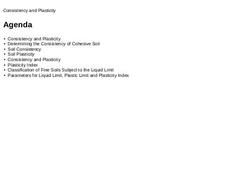
|
|
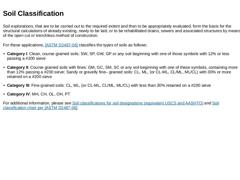
|
Soil explorations, that are to be carried out to the required extent and then to be appropriately evaluated, form the basis for the structural calculations of already existing, newly to be laid, or to be rehabilitated drains, sewers and associated structures by means of the open cut or trenchless method of construction.
For these applications, [[ASTM D2487-06]] classifies the types of soils as follows: |
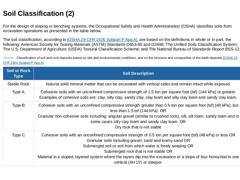
|
For the design of sloping or benching systems, the Occupational Safety and Health Administration (OSHA) classifies soils from excavation operations as presented in the table below. The soil classification, according to [[OSHA 29 CFR 1926 Subpart P App A]], are based on the definitions in whole or in part, the following; American Society for Testing Materials (ASTM) Standards D653-85 and D2488; The Unified Soils Classification System; The U.S. Department … |
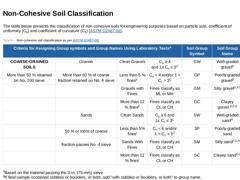
|
The table below presents the classification of non-cohesive soils for engineering purposes based on particle size, coefficient of uniformity (Cu) and coefficient of curvature (Cc) [[ASTM D2487-06]]. (Table: Non-cohesive soil classification as per ASTM D2487) |
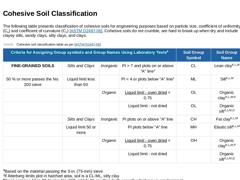
|
The following table presents classification of cohesive soils for engineering purposes based on particle size, coefficient of uniformity (Cu) and coefficient of curvature (Cc) [[ASTM D2487-06]]. Cohesive soils do not crumble, are hard to break up when dry and include clayey silts, sandy clays, silty clays, and clays. (Table: Cohesive soil classification as per ASTM D2487) |
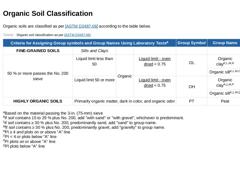
|
Organic soils are classified as per [[ASTM D2487-06]] according to the table below. (Table: Organic soil classification as per ASTM D2487) |
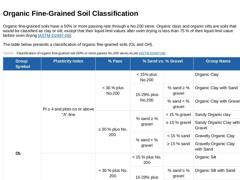
|
Organic fine-grained soils have a 50% or more passing rate through a No.200 sieve. Organic clays and organic silts are soils that would be classified as clay or silt, except that their liquid limit values after oven drying is less than 75 % of their liquid limit value before oven drying [[ASTM D2487-06]]. The table below presents a classification of organic fine-grained soils (OL and OH). (Table: Classification of organic fine-grained soil (50% or … |
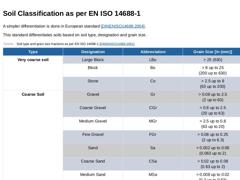
|
A simpler differentiation is done in European standard [DINENISO14688:2004]. This standard differentiates soils based on soil type, designation and grain size. (Table: Soil type and grain size fractions as per EN ISO 14688-1) |
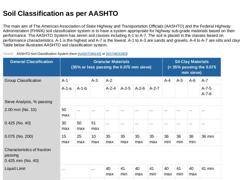
|
The main aim of The American Association of State Highway and Transportation Officials (AASHTO) and the Federal Highway Administration (FHWA) soil classification system is to have a system appropriate for highway sub-grade materials based on their performance. The AASHTO System has seven soil classes including A-1 to A-7. The soil is placed in the classes based on performance characteristics. A-1 is the highest and A-7 is the lowest. A-1 to A-3 are … |
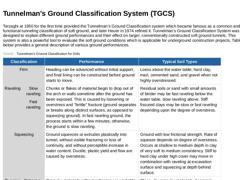
|
Terzaghi at 1950 for the first time provided the Tunnelman’s Ground Classification system which became famous as a common and functional tunneling classification of soft ground, and later Heuer in 1974 refined it. Tunnelman’s Ground Classification System was designed to explain different ground performances and their effect on larger, conventionally constructed soft ground tunnels. This system is also a powerful tool to evaluate the soft ground conditions … |